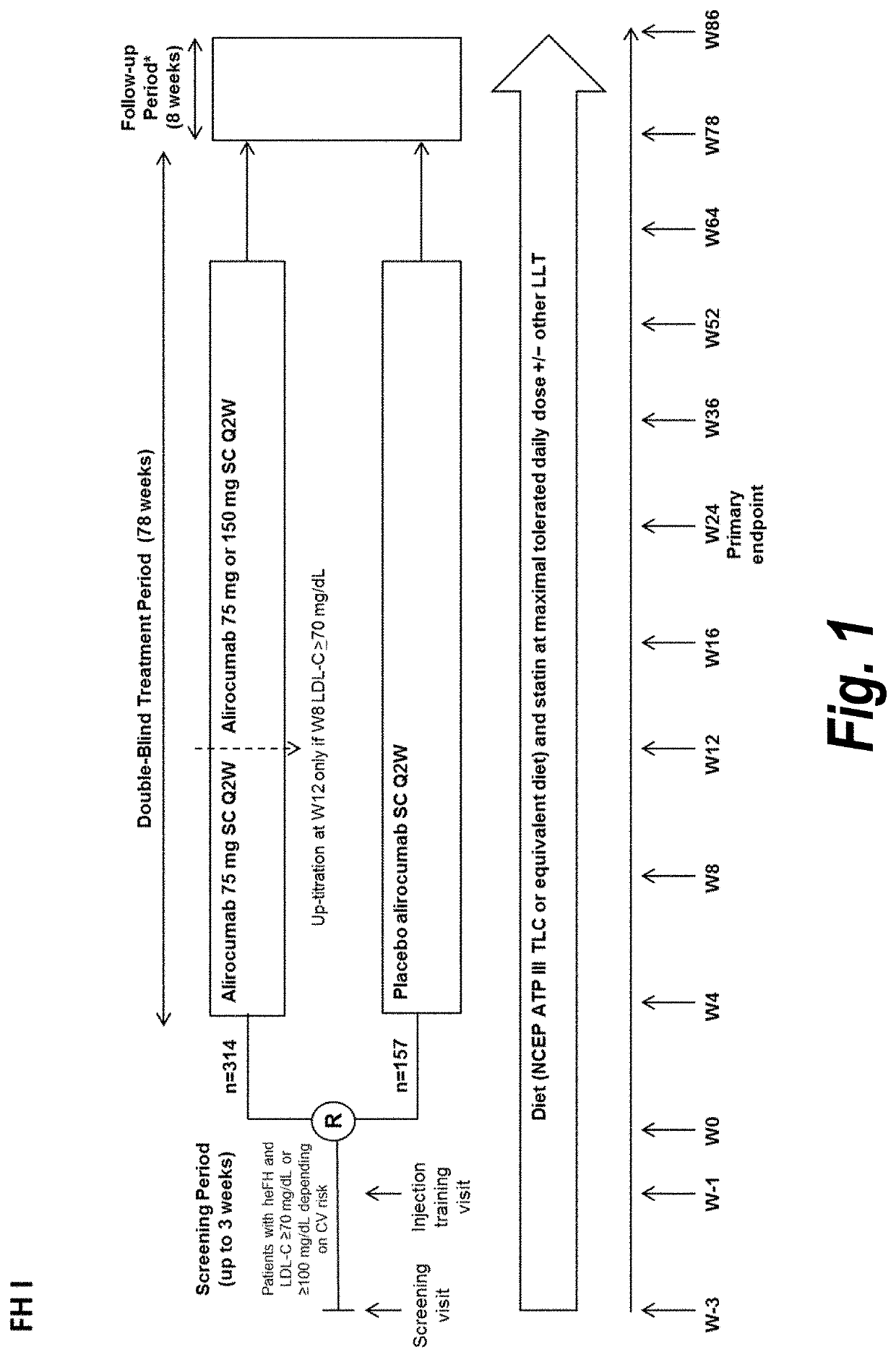Methods for treating patients with heterozygous familial hypercholesterolemia (heFH) with an anti-PCSK9 antibody
a family history and antibody technology, applied in the field of disease and disorder treatment, can solve the problems high risk of cv disease, poor control of low-density lipoprotein cholesterol in patients at risk of cardiovascular disease (cvd), etc., and achieve the reduction of apolipoprotein b, the effect of improving at least one hypercholesterolemia-associated, and reducing the patient's low-density lipoprotein cholesterol
- Summary
- Abstract
- Description
- Claims
- Application Information
AI Technical Summary
Benefits of technology
Problems solved by technology
Method used
Image
Examples
example 1
n of Human Antibodies to Human PCSK9
[0106]Human anti-PCSK9 antibodies were generated as described in U.S. Pat. No. 8,062,640. The exemplary PCSK9 inhibitor used in the following Examples is the human anti-PCSK9 antibody designated “mAb316P,” also known as “Alirocumab.” mAb316P has the following amino acid sequence characteristics: heavy chain variable region (HCVR) comprising SEQ ID NO:1; light chain variable domain (LCVR) comprising SEQ ID NO:6; heavy chain complementarity determining region 1 (HCDR1) comprising SEQ ID NO:2; HCDR2 comprising SEQ ID NO:3; HCDR3 comprising SEQ ID NO:4; light chain complementarity determining region 1 (LCDR1) comprising SEQ ID NO:7; LCDR2 comprising SEQ ID NO:8; and LCDR3 comprising SEQ ID NO:10.
example 2
zed, Double-Blind, Placebo-Controlled, Parallel Group Study to Evaluate the Efficacy and Safety of Alirocumab in Patients with Heterozygous Familial Hypercholesterolemia not Adequately Controlled with their Lipid-Modifying Therapy
Introduction
[0107]This study included patients with heterozygous familial hypercholesterolemia (heFH) with or without a history of documented myocardial infarction (MI) or ischemic stroke.
[0108]The objective of the study was to assess the efficacy and safety of Alirocumab in patients with heFH and who require additional pharmacological management since their current lipid-modifying therapy (LMT) failed to achieve the LDL-C treatment goal.
[0109]This study (FIG. 1) was undertaken to demonstrate in heFH patients who are not at their LDL-C goal that Alirocumab 75 mg Q2W or 75 mg Q2W / 150 mg Q2W as add-on therapy to statin ±other LMT causes a statistically significant and clinically meaningful reduction in LDL-C. This population that is not at LDL-C goal on optim...
example 3
zed, Double-Blind, Placebo-Controlled, Parallel-Group Study to Evaluate the Efficacy and Safety of Alirocumab in Patients with Heterozygous Familial Hypercholesterolemia not Adequately Controlled with their Lipid-Modifying Therapy
Introduction
[0206]The objective of the study was to assess the efficacy and safety of Alirocumab in improving lipid parameters in patients with heterozygous familial hypercholesterolemia (heFH) who have failed to reach their LDL-C treatment goal on maximally-tolerated statin therapy, with or without additional lipid-modifying therapy (LMT). Patients not at goal on a maximally-tolerated dose of daily statin therapy, with or without other LMT, were enrolled in this study, and that their background treatment was maintained throughout the study.
[0207]This specific study (FIG. 3) was undertaken to demonstrate in heFH patients who were not at their LDL-C goal, that Alirocumab 75 mg q2w or 75 mg q2w / 150 mg q2w as add-on therapy to statin+ / −other LMT, causes a stat...
PUM
| Property | Measurement | Unit |
|---|---|---|
| density lipoprotein | aaaaa | aaaaa |
| density | aaaaa | aaaaa |
| concentration | aaaaa | aaaaa |
Abstract
Description
Claims
Application Information
 Login to View More
Login to View More - R&D
- Intellectual Property
- Life Sciences
- Materials
- Tech Scout
- Unparalleled Data Quality
- Higher Quality Content
- 60% Fewer Hallucinations
Browse by: Latest US Patents, China's latest patents, Technical Efficacy Thesaurus, Application Domain, Technology Topic, Popular Technical Reports.
© 2025 PatSnap. All rights reserved.Legal|Privacy policy|Modern Slavery Act Transparency Statement|Sitemap|About US| Contact US: help@patsnap.com



